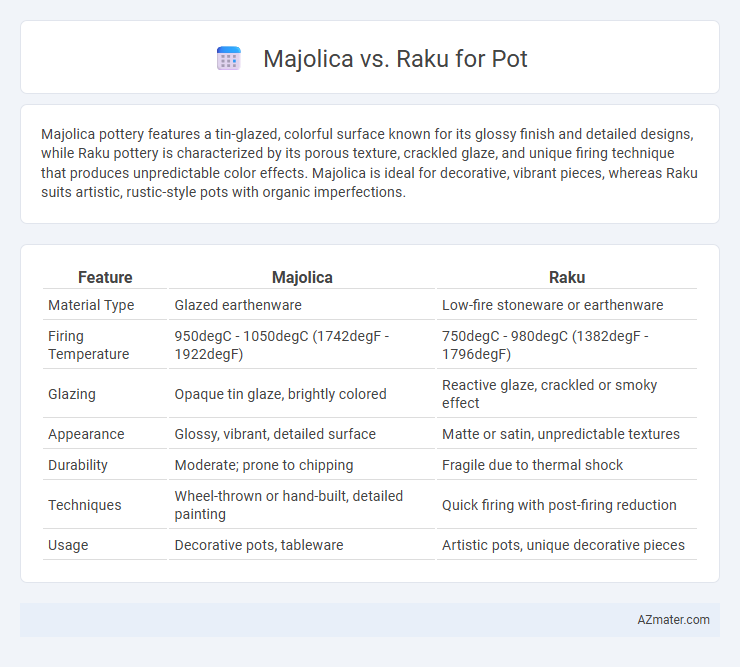Majolica pottery features a tin-glazed, colorful surface known for its glossy finish and detailed designs, while Raku pottery is characterized by its porous texture, crackled glaze, and unique firing technique that produces unpredictable color effects. Majolica is ideal for decorative, vibrant pieces, whereas Raku suits artistic, rustic-style pots with organic imperfections.
Table of Comparison
| Feature | Majolica | Raku |
|---|---|---|
| Material Type | Glazed earthenware | Low-fire stoneware or earthenware |
| Firing Temperature | 950degC - 1050degC (1742degF - 1922degF) | 750degC - 980degC (1382degF - 1796degF) |
| Glazing | Opaque tin glaze, brightly colored | Reactive glaze, crackled or smoky effect |
| Appearance | Glossy, vibrant, detailed surface | Matte or satin, unpredictable textures |
| Durability | Moderate; prone to chipping | Fragile due to thermal shock |
| Techniques | Wheel-thrown or hand-built, detailed painting | Quick firing with post-firing reduction |
| Usage | Decorative pots, tableware | Artistic pots, unique decorative pieces |
Introduction to Majolica and Raku Pottery
Majolica pottery features a tin-glazed earthenware technique originating from the Renaissance, characterized by vibrant, opaque, and colorful surface decoration ideal for decorative pots. Raku pottery, rooted in Japanese tea ceremonies, involves rapid firing and cooling processes that create unique crackled textures and organic, unpredictable finishes on the pot's surface. Both techniques emphasize artistic expression, with Majolica showcasing detailed painted designs and Raku offering a more spontaneous, rustic aesthetic.
Historical Origins of Majolica and Raku
Majolica pottery originated during the Italian Renaissance in the 15th century, characterized by its vibrant tin-glazed earthenware decorated with intricate patterns and vivid colors. Raku, on the other hand, traces back to 16th-century Japan, developed as a traditional tea ceremony pottery technique involving a rapid-fire glazing process that results in unique crackled textures and smoky effects. The distinct historical origins of Majolica and Raku reflect their cultural contexts and artistic priorities, with Majolica emphasizing ornate decoration and Raku focusing on spontaneous natural aesthetics.
Key Differences in Materials Used
Majolica pottery is typically made using a tin-glazed earthenware clay that creates a bright, opaque white surface ideal for vivid overglaze decoration. Raku pottery involves a porous, low-fired clay body that withstands rapid cooling and thermal shock, essential for the unique crackling and smoky effects achieved during its removal from the kiln. The key difference lies in Majolica's use of a heavy tin glaze for a smooth, glossy finish, versus Raku's emphasis on resistive clay and post-firing reduction techniques that produce textured, unpredictable surfaces.
Firing Techniques: Majolica vs Raku
Majolica pottery involves a high-temperature firing process followed by a second firing to set the tin glaze and colorful overglaze decoration, resulting in a durable, glossy finish. In contrast, Raku firing is a rapid, low-temperature process where pots are removed from the kiln while glowing hot and subjected to post-firing reduction in combustible materials, creating unique crackle effects and smoky patterns. The controlled oxidation and reduction atmospheres in Majolica produce consistent, vibrant surfaces, whereas Raku's unpredictable thermal shock fosters distinctive, one-of-a-kind textures and finishes.
Color and Glazing Characteristics
Majolica pottery features vibrant, opaque colors achieved through tin-glaze techniques, creating a glossy and smooth surface that enhances intricate painted designs. Raku pottery, by contrast, displays a more organic and unpredictable color palette with metallic and crackled glaze effects due to rapid cooling methods. The glazing on Majolica is thick and reflective, while Raku's glaze is often matte or textured with unique surface variations from its traditional firing process.
Surface Texture and Finish Comparison
Majolica pots feature a smooth, glossy surface achieved through a lead-glazed tin enamel that provides vibrant, opaque colors and a glass-like finish. In contrast, Raku pots have a distinctive rough and crackled texture created by rapid cooling during firing, resulting in unpredictable surface patterns with matte or metallic sheens. The finish of Majolica is uniform and polished, ideal for decorative purposes, while Raku's tactile, organic surface emphasizes a rustic, handcrafted aesthetic.
Durability and Functionality of Finished Pots
Majolica pots feature a thick, glass-like glaze that enhances durability by resisting scratches and stains, making them ideal for everyday use. Raku pots, while artistically unique due to their rapid cooling process, tend to be more fragile and porous, limiting their functionality for holding liquids or heavy plants. The dense, vitrified surface of majolica ensures better water retention and longevity compared to the more brittle and often crack-prone raku finish.
Artistic Expression and Design Possibilities
Majolica pottery showcases vibrant, opaque glazes that enable detailed, colorful surface decoration ideal for narrative or floral motifs, enhancing bold artistic expression. Raku firing produces unpredictable crackled textures and smoky hues, offering unique, organic aesthetics that emphasize spontaneity and natural imperfection in design. Both techniques provide diverse creative opportunities: Majolica for intricate painted patterns and Raku for tactile, one-of-a-kind finishes that appeal to different artistic sensibilities.
Care, Maintenance, and Longevity
Majolica pottery requires gentle cleaning with mild soap and water to preserve its vibrant glaze, avoiding abrasive materials that can cause chipping or fading. Raku pots, being more porous and fragile due to their rapid firing process, need careful handling and sealing with a suitable resin to prevent moisture absorption and cracking over time. Proper care and maintenance of both types extend their longevity, with Majolica offering greater durability for everyday use and Raku prized for its unique, delicate aesthetic best suited for decorative purposes.
Choosing the Right Pottery Style for Your Needs
Majolica pottery offers vibrant, glossy glazes ideal for decorative pots that showcase intricate patterns and bright colors, enhancing any indoor or outdoor space. Raku pottery stands out with its unique crackled surface and earthy, rustic appeal, perfect for artistic, one-of-a-kind pots that emphasize natural textures and improvisational firing techniques. Selecting between Majolica and Raku depends on whether you prioritize vivid aesthetics and durability or handcrafted, organic character and unpredictable finishes in your pottery collection.

Infographic: Majolica vs Raku for Pot
 azmater.com
azmater.com